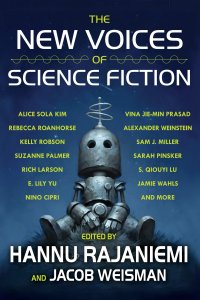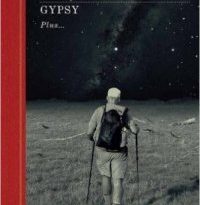Gary K. Wolfe reviews Caitlín R. Kiernan
 A few years ago in a Locus interview, Peter Straub spoke of the seldom-acknowledged and hard-to-articulate relationship between the experience of horror and the experience of transcendence, and it may be that one of the reasons it’s hard to articulate is that relatively few horror writers have even tried to take a serious shot at exploring it. But one of the most brilliant evocations I’ve read of this precise notion is Caitlín R. Kiernan’s ‘‘Onion’’, which is one of the finest stories in the generally excellent (and aptly titled) Two Worlds and in Between, the first of two projected volumes of The Best of Caitlín R. Kiernan. The story begins with the seven-year-old Frank glimpsing an impossible world of crimson fields through a crack in his basement wall, and follows him through a seedy life and marriage to a woman also plagued by sometimes terrifying visions. But in the end the real horror, as is often the case with Kiernan’s lost and desperate characters in gritty settings, isn’t so much what invades our lives as what’s excluded from them.
A few years ago in a Locus interview, Peter Straub spoke of the seldom-acknowledged and hard-to-articulate relationship between the experience of horror and the experience of transcendence, and it may be that one of the reasons it’s hard to articulate is that relatively few horror writers have even tried to take a serious shot at exploring it. But one of the most brilliant evocations I’ve read of this precise notion is Caitlín R. Kiernan’s ‘‘Onion’’, which is one of the finest stories in the generally excellent (and aptly titled) Two Worlds and in Between, the first of two projected volumes of The Best of Caitlín R. Kiernan. The story begins with the seven-year-old Frank glimpsing an impossible world of crimson fields through a crack in his basement wall, and follows him through a seedy life and marriage to a woman also plagued by sometimes terrifying visions. But in the end the real horror, as is often the case with Kiernan’s lost and desperate characters in gritty settings, isn’t so much what invades our lives as what’s excluded from them.
This may be one reason that Caitlín R. Kiernan has vocally, and quite reasonably, resisted the label of ‘‘horror writer’’: while horror characteristically wants to get at the effect that provides its name, Kiernan (like Straub and a few others) is more likely to want to explore the after-effects, the resonances that echo through the lives of characters, families, communities, even occasionally history (as when she unpacks a hidden story behind the Johnstown Flood in ‘‘To This Water’’ or traces Mina Harker’s life after Dracula deep into the 20th century in ‘‘Emptiness Spoke Eloquent’’, the earliest story in the collection). She can, as she persuasively and repeatedly demonstrates, creep you out with the best of them (though she seldom sets out to merely frighten), and her lush fiction is well-enough populated with familiar furniture like vampires, zombies, crumbling mansions, underground catacombs, and dread infestations. She sometimes alludes to iconic figures like Lovecraft or even to Charles Fort, who preceded HPL in his systematized cultural paranoia, but Kiernan’s language and sensibility – which is where her fiction lives – owes as much to Verlaine as to Lovecraft (there’s even an absinthe story here), and those references to Fort and others are balanced by allusions to everyone from Blake to Zelda Fitzgerald. Kiernan, in other words, is a far more complex writer than she may at first appear, despite the well-deserved praise heaped on such novels as the recent The Red Tree.
The reason I said that Two Worlds and in Between is an apt title (borrowed from the third story in the collection, a rather unique take on zombies) is that it resonates in various ways with both Kiernan’s career – balanced sometimes between horror and Southern Gothic, between street punk sensibility and a scientist’s eye for detail (Kiernan was trained as a paleontologist), and sometimes between the rationalist surfaces of SF and the unreliability of perception (as in ‘‘The Dry Salvages’’, the longest piece here, which makes effective use of her scientific training but is most effective in its portrayal of a frozen postapocalyptic Paris through the eyes of a decidedly unreliable narrator trying to remember events from a half century on). The title also resonates with the lives of her characters, who often occupy liminal spaces on the edges of society, sometimes even between life and death. One of the most beautiful stories, ‘‘La Peau Verte’’ (that’s the one with the absinthe) concerns an artist trapped between the viewing and the viewed; her own painting career stalled, she takes elaborately costumed modeling jobs as she tries to come to terms with the death of her sister years earlier. (Artists, writers, and performers are recurring figures in many stories.) Some of the most memorable of those characters come with complex family histories; the cynical performance artist Salmagundi Desvernine interviewed in ‘‘Salmagundi (New York City, 1981)’’ turns out to be the great granddaughter of the shipping magnate Silas Desvernine who confronts an ancient power in his Hudson River palace in ‘‘Estate’’. ‘‘Andromeda Among the Stones’’ (in which Silas Desvernine is also mentioned), the most overtly Lovecraftian tale here, covers some 25 years in the history of the Dandridge family, who also feature in other Kiernan stories.
Kiernan offers brief afterwords in which she places the stories in the context of her own developing voice (she names ‘‘Andromeda Among the Stones’’ as a ‘‘turning point’’ when ‘‘my voice shifted’’), and she makes some valid points. It’s always a bit of a risk to begin a ‘‘best of’’ volume with your earliest work – although the very first story here, the Dracula quasi-sequel ‘‘Emptiness Spoke Eloquent’’ is quite strong and moving – and indeed we can sense an evolution from a young author infatuated with language, given to portmanteau words, coloratura descriptions, and baroque character names, toward an artist meticulously in control of her voice and her material. But even at the beginning it was clear that Kiernan would emerge as one of the most distinctive voices of fantastic literature of the last few decades, and by the time we get to the final story, ‘‘Houses Under the Sea’’, an elegantly nuanced tale of a reporter coming to terms with his former lover who became leader of a notorious suicide cult, it’s clear that neither the passion nor that problematical sense of transcendence have abated at all. This is certainly one of the major collections of the year, and it makes you wish the second volume were here now.







Pingback:TOD 026 Two BizarroCon Panels: ‘The Road to Publication’ and ‘The Weird in a Post-Weird World’ – This Is Horror